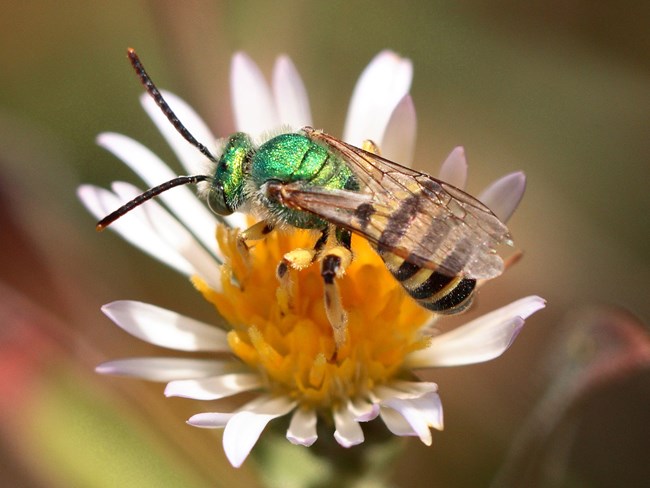
NPS / Paul Johnson
While the iconic European honeybee (Apis mellifera) is a familiar San Francisco Bay Area resident, hundreds of native bee species live here, too. Our native bees come in every conceivable shape, color, and size—from tiny shimmering metallic sweat bees to big fuzzy bumblebees. Many live alone, rather than in colonies, and most build their nests in dirt or sand burrows rather than in hives. Others, called kleptoparasites or cuckoo bees, only lay their eggs in other bees’ nests.
As essential pollinators of both agricultural crops and native plants, California’s roughly 1600 native bee species play a vital role in just about every kind of terrestrial ecosystem. But, despite how important they are, we know very little about the bees that live on National Park Service lands, and even less about what effects climate change might have on them.
Some Bay Area national parks are taking steps to try to catalog and understand their apian diversity a little better by sampling bees and noting what plant species they prefer. A more complete understanding of the parks’ bees will not only help managers care for them and their habitats now, but also be able to better predict what might happen as climate and park habitats change in the future.
Pinnacles: According to a late-90s study by the U.S. Department of Agriculture’s Logan Bee Lab in Utah, nearly 400 bee species live in the park’s 25 square-miles—more than any other surveyed area its size on Earth! "Researchers from Utah State University returned to the park for additional surveys between 2011 and 2012, and found another 48 bee species.
John Muir: A 2002 survey found 70 different species of bees at the John Muir National Historic Site, but park biologists suspect that there may be more that were not captured by this preliminary sampling effort. To that end, park staff and interns are currently surveying bees in a variety of park habitats to try to get a more thorough understanding of bee diversity and bee-plant associations in the park.
The Presidio: A 2004 bee study found 60 species of bees in the Presidio, and some indication that habitat degradation and disturbance were not necessarily limiting bee species diversity or abundance. A follow-up survey in 2008 found six more bee species, bringing the total to 66, and also found that bee diversity and abundance had changed dramatically at all the surveyed sites.
References and Links
Explore more research, reports, and resources on bees in San Francisco Bay Area parks.
Source: NPS DataStore Saved Search 3579. To search for additional information, visit the NPS DataStore.
Multimedia
-
It's the Bees Knees
John Muir made his money as a fruit grower—depending on bees for his orchards. A closer look reveals an astounding number of bee species in John Muir National Historic Site in Martinez, California. Bee surveys being conducted in areas of the park are revealing a growing inventory of bee species and exciting details about the plants they're pollinating. Meet two field interns as they discuss the work and its challenges.
- Duration:
- 3 minutes, 46 seconds
-
The Natural Laboratory: Bees of Pinnacles National Park
This podcast includes interviews with park staff and scientists about why Pinnacles bees might be so diverse and why it matters.
Blog
See below for the latest on bees from the Bay Area Nature & Science Blog.
Last updated: May 22, 2020

